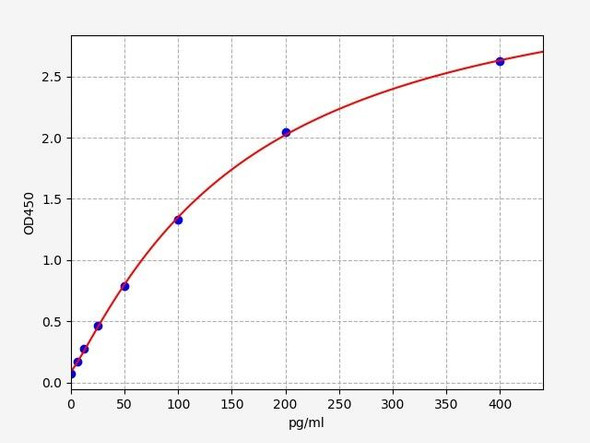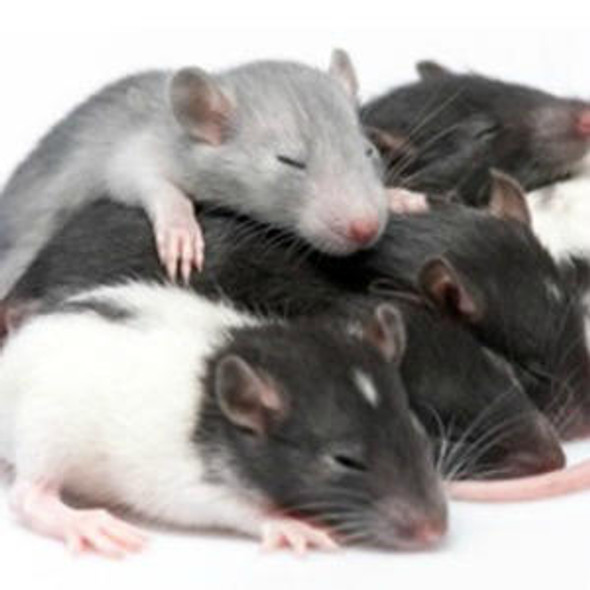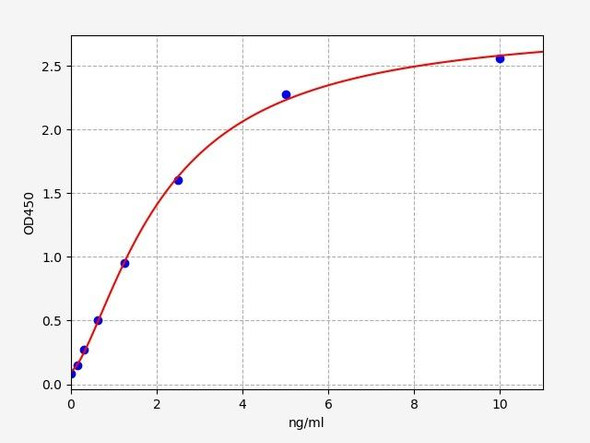Rat Early Growth Response Protein 2 / EGR2 ELISA Kit
- SKU:
- RTFI00744
- Product Type:
- ELISA Kit
- Size:
- 96 Assays
- Uniprot:
- P51774
- Sensitivity:
- 0.188ng/ml
- Range:
- 0.313-20ng/ml
- ELISA Type:
- Sandwich ELISA, Double Antibody
- Synonyms:
- EGR2
- Reactivity:
- Rat
Description
| Product Name: | Rat EGR2 (Early Growth Response Protein 2) ELISA Kit |
| Product Code: | RTFI00744 |
| Size: | 96 Assays |
| Target: | Rat EGR2 |
| Alias: | EGR2 |
| Reactivity: | Rat |
| Detection Method: | Sandwich ELISA, Double Antibody |
| Sensitivity: | 0.188ng/ml |
| Range: | 0.313-20ng/ml |
| Storage: | 4°C for 6 months |
| Note: | For Research Use Only |
| Recovery: | Matrices listed below were spiked with certain level of Rat EGR2 and the recovery rates were calculated by comparing the measured value to the expected amount of Rat EGR2 in samples. | ||||||||||||||||
| |||||||||||||||||
| Linearity: | The linearity of the kit was assayed by testing samples spiked with appropriate concentration of Rat EGR2 and their serial dilutions. The results were demonstrated by the percentage of calculated concentration to the expected. | ||||||||||||||||
| |||||||||||||||||
| Intra-Assay: | CV <8% | ||||||||||||||||
| Inter-Assay: | CV <10% |
| Uniprot: | P51774 |
| UniProt Protein Function: | EGR1: Transcriptional regulator. Recognizes and binds to the DNA sequence 5'-CGCCCCCGC-3'(EGR-site). Activates the transcription of target genes whose products are required for mitogenesis and differentiation. By growth factors. Belongs to the EGR C2H2-type zinc-finger protein family. |
| UniProt Protein Details: | Protein type:DNA-binding; C2H2-type zinc finger protein; Transcription factor Chromosomal Location of Human Ortholog: 5q31.1 Cellular Component: nucleoplasm; cytoplasm; nucleus Molecular Function:histone acetyltransferase binding; protein binding; DNA binding; sequence-specific DNA binding; metal ion binding; double-stranded DNA binding; transcription factor binding; transcription factor activity Biological Process: regulation of long-term neuronal synaptic plasticity; transcription from RNA polymerase II promoter; response to nutrient levels; circadian rhythm; positive regulation of transcription, DNA-dependent; cytokine and chemokine mediated signaling pathway; response to amphetamine; negative regulation of transcription from RNA polymerase II promoter; response to cocaine; BMP signaling pathway; response to ethanol; learning and/or memory; cellular response to insulin stimulus; positive regulation of neuron apoptosis; response to glucose stimulus; oligodendrocyte differentiation; positive regulation of transcription from RNA polymerase II promoter; response to electrical stimulus; negative regulation of apoptosis; regulation of protein sumoylation; T cell differentiation |
| NCBI Summary: | The protein encoded by this gene belongs to the EGR family of C2H2-type zinc-finger proteins. It is a nuclear protein and functions as a transcriptional regulator. The products of target genes it activates are required for differentitation and mitogenesis. Studies suggest this is a cancer suppresor gene. [provided by RefSeq, Jul 2008] |
| UniProt Code: | P51774 |
| NCBI GenInfo Identifier: | 4503493 |
| NCBI Gene ID: | 1958 |
| NCBI Accession: | NP_001955.1 |
| UniProt Secondary Accession: | P51774,P11161, P08046, P08152, P08154, P51774, |
| UniProt Related Accession: | P18146 |
| Molecular Weight: | 57,507 Da |
| NCBI Full Name: | early growth response protein 1 |
| NCBI Synonym Full Names: | early growth response 1 |
| NCBI Official Symbol: | EGR1 |
| NCBI Official Synonym Symbols: | TIS8; AT225; G0S30; NGFI-A; ZNF225; KROX-24; ZIF-268 |
| NCBI Protein Information: | early growth response protein 1; EGR-1; zinc finger protein 225; transcription factor ETR103; transcription factor Zif268; zinc finger protein Krox-24; nerve growth factor-induced protein A |
| UniProt Protein Name: | Early growth response protein 1 |
| UniProt Synonym Protein Names: | AT225; Nerve growth factor-induced protein A; NGFI-A; Transcription factor ETR103; Transcription factor Zif268; Zinc finger protein 225; Zinc finger protein Krox-24 |
| Protein Family: | E3 SUMO-protein ligase |
| UniProt Gene Name: | EGR1 |
| UniProt Entry Name: | EGR1_HUMAN |
| Step | Procedure |
| 1. | Set standard, test sample and control (zero) wells on the pre-coated plate respectively, and then, record their positions. It is recommended to measure each standard and sample in duplicate. Wash plate 2 times before adding standard, sample and control (zero) wells! |
| 2. | Aliquot 0.1ml standard solutions into the standard wells. |
| 3. | Add 0.1 ml of Sample / Standard dilution buffer into the control (zero) well. |
| 4. | Add 0.1 ml of properly diluted sample ( Human serum, plasma, tissue homogenates and other biological fluids.) into test sample wells. |
| 5. | Seal the plate with a cover and incubate at 37°C for 90 min. |
| 6. | Remove the cover and discard the plate content, clap the plate on the absorbent filter papers or other absorbent material. Do NOT let the wells completely dry at any time. Wash plate X2. |
| 7. | Add 0.1 ml of Biotin- detection antibody working solution into the above wells (standard, test sample & zero wells). Add the solution at the bottom of each well without touching the side wall. |
| 8. | Seal the plate with a cover and incubate at 37°C for 60 min. |
| 9. | Remove the cover, and wash plate 3 times with Wash buffer. Let wash buffer rest in wells for 1 min between each wash. |
| 10. | Add 0.1 ml of SABC working solution into each well, cover the plate and incubate at 37°C for 30 min. |
| 11. | Remove the cover and wash plate 5 times with Wash buffer, and each time let the wash buffer stay in the wells for 1-2 min. |
| 12. | Add 90 µL of TMB substrate into each well, cover the plate and incubate at 37°C in dark within 10-20 min. (Note: This incubation time is for reference use only, the optimal time should be determined by end user.) And the shades of blue can be seen in the first 3-4 wells (with most concentrated standard solutions), the other wells show no obvious color. |
| 13. | Add 50 µL of Stop solution into each well and mix thoroughly. The color changes into yellow immediately. |
| 14. | Read the O.D. absorbance at 450 nm in a microplate reader immediately after adding the stop solution. |
When carrying out an ELISA assay it is important to prepare your samples in order to achieve the best possible results. Below we have a list of procedures for the preparation of samples for different sample types.
| Sample Type | Protocol |
| Serum: | If using serum separator tubes, allow samples to clot for 30 minutes at room temperature. Centrifuge for 10 minutes at 1,000x g. Collect the serum fraction and assay promptly or aliquot and store the samples at -80°C. Avoid multiple freeze-thaw cycles. If serum separator tubes are not being used, allow samples to clotovernight at 2-8°C. Centrifuge for 10 minutes at 1,000x g. Removeserum and assay promptly or aliquot and store the samples at-80°C. Avoid multiple freeze-thaw cycles. |
| Plasma: | Collect plasma using EDTA or heparin as an anti-coagulant. Centrifuge samples at 4°C for 15 mins at 1000 — g within 30 mins of collection. Collect the plasma fraction and assay promptly or aliquot and store the samples at -80°C. Avoid multiple freeze-thaw cycles.Note: Over haemolysed samples are not suitable for use with this kit. |
| Urine & Cerebrospinal Fluid: | Collect the urine (mid-stream) in a sterile container, centrifuge for 20 mins at 2000-3000 rpm. Remove supernatant and assay immediately. If any precipitation is detected, repeat the centrifugation step. A similar protocol can be used for cerebrospinal fluid. |
| Cell Culture Supernatant: | Collect the cell culture media by pipette, followed by centrifugation at 4°C for 20 mins at 1500 rpm. Collect the clear supernatant and assay immediately. |
| Cell Lysates: | Solubilize cells in lysis buffer and allow to sit on ice for 30 minutes. Centrifuge tubes at 14,000 x g for 5 minutes to remove insoluble material. Aliquot the supernatant into a new tube and discard the remaining whole cell extract. Quantify total protein concentration using a total protein assay. Assay immediately or aliquot and store at ≤ -20°C. |
| Tissue Homogenates: | The preparation of tissue homogenates will vary depending upon tissue type. Rinse tissue with 1X PBS to remove excess blood & homogenizein 20ml of 1X PBS (including protease inhibitors) and store overnight at ≤ -20°C. Two freeze-thaw cycles are required to break the cell membranes. To further disrupt the cell membranes you can sonicate the samples. Centrifuge homogenates for 5 mins at 5000xg. Remove the supernatant and assay immediately or aliquot and store at -20°C or-80°C. |
| Tissue Lysates: | Rinse tissue with PBS, cut into 1-2 mm pieces, and homogenize with a tissue homogenizer in PBS. Add an equal volume of RIPA buffer containing protease inhibitors and lyse tissues at room temperature for 30 minutes with gentle agitation. Centrifuge to remove debris. Quantify total protein concentration using a total protein assay. Assay immediately or aliquot and store at ≤ -20 °C. |
| Breast Milk: | Collect milk samples and centrifuge at 10,000 x g for 60 min at 4°C. Aliquot the supernatant and assay. For long term use, store samples at -80°C. Minimize freeze/thaw cycles. |










